Working professionals
Fresh graduates
- Study abroad
- Offline centres
More
1. SQL Tutorial
3. SQL Commands
5. SQL Aliases
10. SQL WHERE Clause
11. SQL AND Operator
13. SQL Like
16. MySQL Workbench
22. Index in SQL
24. Schema in SQL
31. SQL ORDER BY
38. NVL in SQL
41. SQL Wildcards
45. GROUP BY in SQL
46. SQL HAVING
47. EXISTS in SQL
48. SQL Joins
53. Self Join SQL
54. Left Join in SQL
57. Cursor in SQL
58. Triggers In SQL
61. REPLACE in SQL
63. Transact-SQL
64. INSTR in SQL
70. Advanced SQL
71. SQL Subquery
78. MySQL database
79. What is SQLite
80. SQLite
Understanding the ROW_NUMBER() Function in SQL
Introduction
When collaborating with huge datasets in SQL, it is usually necessary to assign serial numbers to each row based on specific standards. This is where the ROW_NUMBER() feature enters into play. In this post, we'll dive deep right into the ROW NUMBER function in SQL, exploring its phrase structure, use, and useful examples. Whether you are a novice or a seasoned SQL individual, recognizing exactly how to utilize the ROW_NUMBER() function efficiently can significantly enhance your information analysis and control capacities.
Overview
What is the ROW_NUMBER() Function?
The ROW_NUMBER() function is a window function in SQL that assigns a unique, sequential number to each row within a partition of a result set. It is used to generate a unique identifier for each row based on the specified ordering criteria.
The ROW NUMBER function in SQL operates on a set of rows defined by the OVER clause, which determines the partitioning and ordering of the rows. It assigns a unique, incremental number to each row within each partition, starting from 1.
Here's a basic example to illustrate the concept:
SELECT
ROW_NUMBER() OVER (ORDER BY ColumnName) AS RowNum,
ColumnName1,
ColumnName2
FROM
TableName;
In this example, the ROW_NUMBER function in SQL is used to assign row numbers to records within each DepartmentID, ordered by Salary in descending order. This results in a new column, RowNum, which contains the assigned row numbers for each record, grouped by department.
Syntax and Usage
The general syntax of the ROW_NUMBER in SQL is as follows:
ROW_NUMBER() OVER (
[PARTITION BY partition_expression]
ORDER BY sort_expression [ASC | DESC]
)
- partition_expression: Specifies the column(s) used to divide the result set into partitions. Each partition will have its own set of row numbers. This part is optional.
- sort_expression: Specifies the column(s) used to determine the ordering of the rows within each partition. The row numbers are assigned based on this ordering.
- ASC | DESC: Specifies the sort order, either ascending (default) or descending.
Sample Data
-- Create the database
CREATE DATABASE EmployeeDB;
GO
-- Use the EmployeeDB database
USE EmployeeDB;
GO
-- Create the Employees table
CREATE TABLE Employees (
EmployeeID INT PRIMARY KEY,
FirstName VARCHAR(50),
LastName VARCHAR(50),
DepartmentID INT,
Salary DECIMAL(10, 2)
);
-- Insert dummy data into the Employees table
INSERT INTO Employees (EmployeeID, FirstName, LastName, DepartmentID, Salary)
VALUES
(1, 'John', 'Doe', 1, 5000.00),
(2, 'Jane', 'Smith', 1, 6000.00),
(3, 'Michael', 'Johnson', 1, 5500.00),
(4, 'Emily', 'Brown', 2, 4500.00),
(5, 'David', 'Wilson', 2, 5200.00),
(6, 'Sarah', 'Taylor', 2, 4800.00),
(7, 'Robert', 'Anderson', 3, 6500.00),
(8, 'Olivia', 'Thomas', 3, 7000.00),
(9, 'James', 'Jackson', 3, 6800.00),
(10, 'Emma', 'White', 1, 5800.00),
(11, 'Daniel', 'Harris', 2, 5100.00),
(12, 'Sophia', 'Martin', 3, 7200.00),
(13, 'Matthew', 'Thompson', 1, 6200.00),
(14, 'Ava', 'Garcia', 2, 4900.00),
(15, 'Andrew', 'Martinez', 3, 7500.00);
Here is an example that demonstrates the use of ROW_NUMBER() with partitioning:
SELECT
ROW_NUMBER() OVER (PARTITION BY DepartmentID ORDER BY Salary DESC) AS RowNum,
EmployeeID,
DepartmentID,
Salary
FROM
Employees;

In this example, the ROW NUMBER function in SQL assigns row numbers within each DepartmentID dividing, bought by Salary in descending order. The resulting RowNum column will certainly contain the appointed row numbers for every department.
What is the Need for a ROW_NUMBER() Function?
The ROW_NUMBER() feature offers several vital functions in SQL:
- Unique Row Recognition: It offers a way to distinctively determine each row within a result set, even if the information itself does not have a natural distinct identifier.
- Pagination: ROW_NUMBER() is usually used for carrying out pagination in SQL inquiries. By designating row numbers, you can quickly retrieve a specific part of the rows based on their position.
- Position and Top-N Evaluation: When utilized in mix with partitioning and ordering, ROW_NUMBER() allows you to place rows within teams or dividers based upon details criteria. This works for scenarios like discovering the top N documents within each group.
- To Eliminate Matches: By designating special row numbers, you can identify and remove replicate rows from a result set.
- Complicated Filtering: ROW_NUMBER() in SQL makes it possible for complicated filtering system scenarios where you need to use problems based on the relative position of rows within dividers.
Here is an example that demonstrates the use of ROW_NUMBER() for pagination:
SELECT *
FROM (
SELECT
ROW_NUMBER() OVER (ORDER BY EmployeeID) AS RowNum,
EmployeeID,
FirstName,
LastName
FROM
Employees
) AS EmployeeWithRowNumber
WHERE
RowNum BETWEEN 11 AND 20;
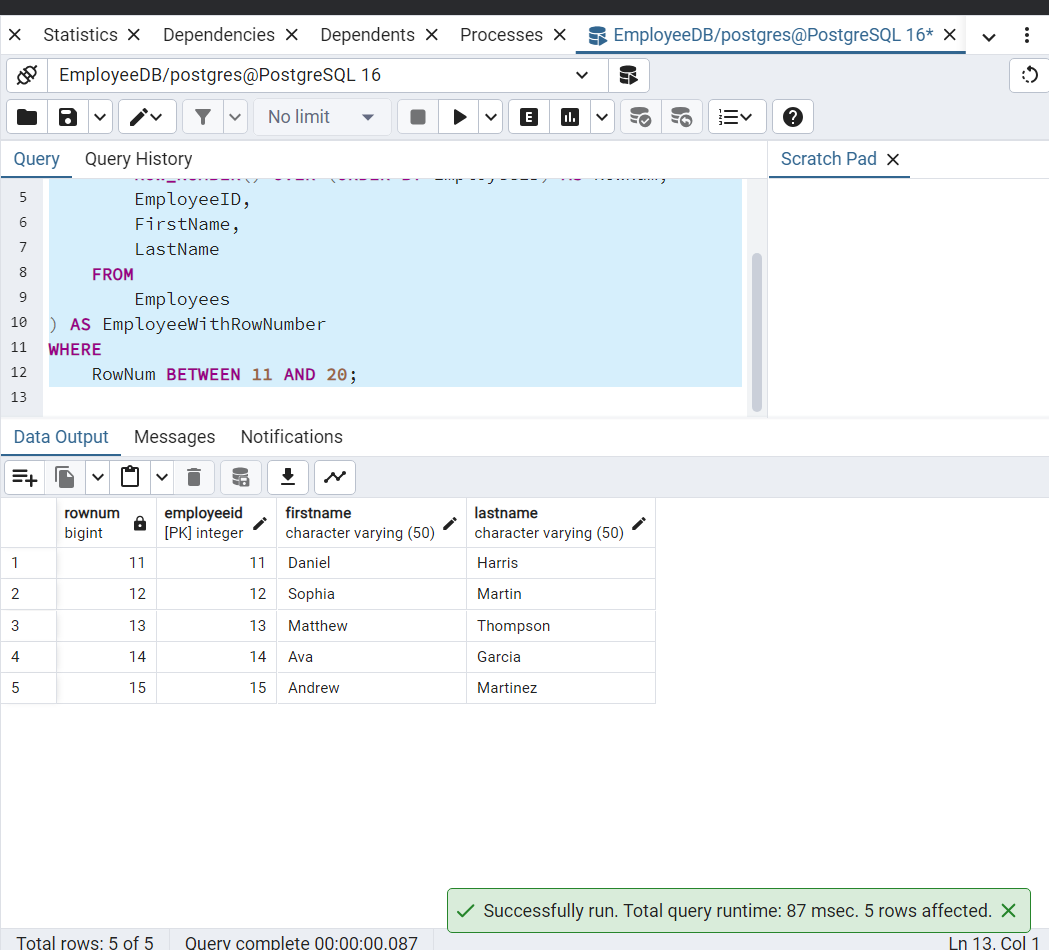
In this example, the ROW_NUMBER() function appoints row numbers based on the EmployeeID column. The outer inquiry then filters the rows where RowNum is between 11 and 20, effectively fetching the 2nd web page of outcomes (presuming 10 rows per web page).
Example Queries
These examples showcase different scenarios where the ROW_NUMBER() function can be applied:
Finding the top 3 employees with the highest salary in each department
SELECT *
FROM (
SELECT
ROW_NUMBER() OVER (PARTITION BY DepartmentID ORDER BY Salary DESC) AS RowNum,
EmployeeID,
DepartmentID,
Salary
FROM
Employees
) AS EmployeeWithRowNumber
WHERE
RowNum <= 3;
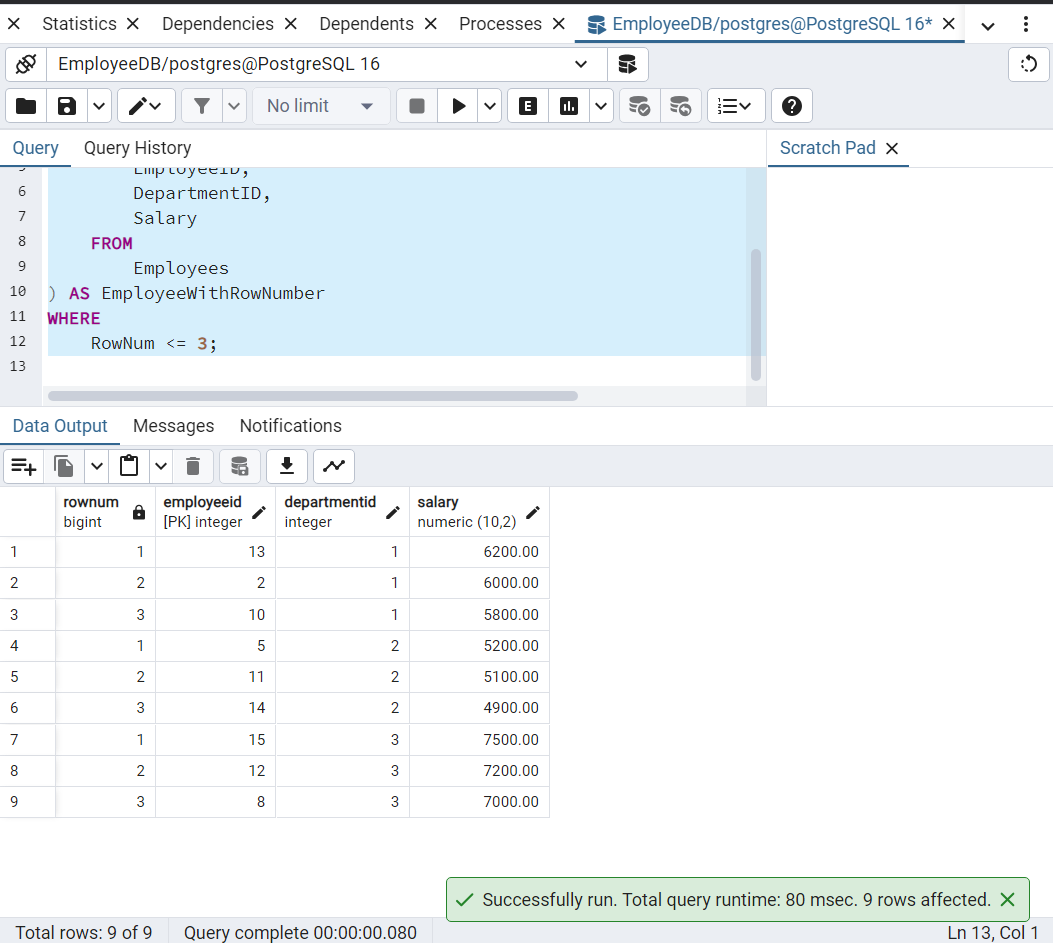
Removing duplicates based on specific columns
WITH CTE AS (
SELECT
ROW_NUMBER() OVER (PARTITION BY FirstName, LastName ORDER BY EmployeeID) AS RowNum,
EmployeeID,
FirstName,
LastName,
DepartmentID,
Salary
FROM
Employees
)
DELETE FROM Employees
WHERE EmployeeID IN (
SELECT EmployeeID
FROM CTE
WHERE RowNum > 1
);

In this example, the common table expression (CTE) assigns row numbers within partitions defined by Column1 and Column2. The DELETE statement then removes rows where RowNum is greater than 1, effectively keeping only the first occurrence of each unique combination of Column1 and Column2.
Pagination - Retrieving the second page of results (assuming 5 rows per page)
SELECT *
FROM (
SELECT
ROW_NUMBER() OVER (ORDER BY EmployeeID) AS RowNum,
EmployeeID,
FirstName,
LastName,
DepartmentID,
Salary
FROM
Employees
) AS EmployeeWithRowNumber
WHERE
RowNum BETWEEN 6 AND 10;
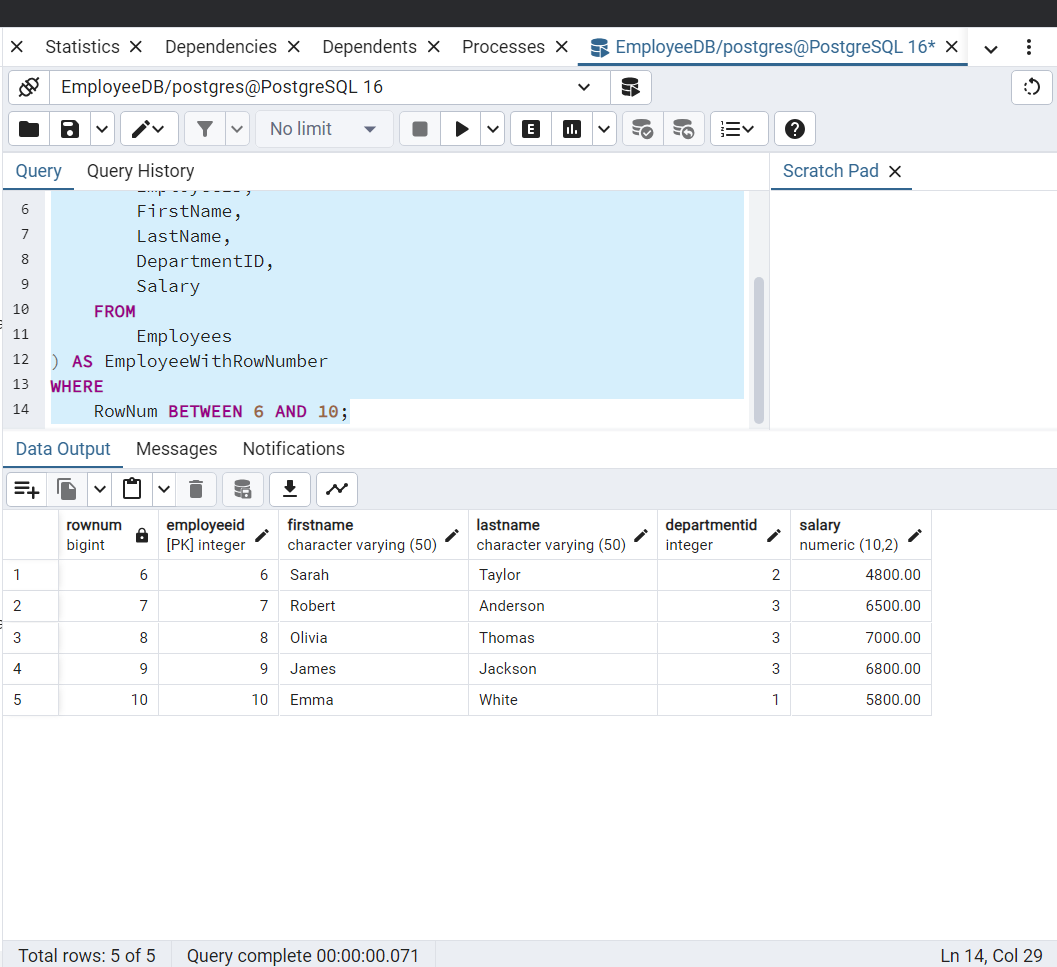
ROW_NUMBER() vs. Other Ranking Functions
Function | ROW_NUMBER() | RANK() | DENSE_RANK() |
Description | Assigns a unique, sequential number to each row within a partition. | Assigns the same rank to ties and skips the next rank value. | Assigns the same rank to ties but does not skip the next rank value. |
Handling Ties | Assigns a unique number to each row, even if there are ties in the ordering criteria. | Assigns the same rank to ties and skips the next rank value. | Assigns the same rank to ties but does not skip the next rank value. |
Use Cases |
|
|
|
Performance |
|
|
|
ROW_NUMBER()
Syntax
ROW_NUMBER() OVER (
[PARTITION BY partition_expression]
ORDER BY sort_expression [ASC | DESC]
)
- partition_expression: Specifies the column(s) used to divide the result set into partitions. Each partition will have its own set of row numbers. This part is optional.
- sort_expression: Specifies the column(s) used to determine the ordering of the rows within each partition. The row numbers are assigned based on this ordering.
- ASC | DESC: Specifies the sort order, either ascending (default) or descending.
Example:
SELECT
ROW_NUMBER() OVER (PARTITION BY DepartmentID ORDER BY Salary DESC) AS RowNum,
EmployeeID,
DepartmentID,
Salary
FROM
Employees;
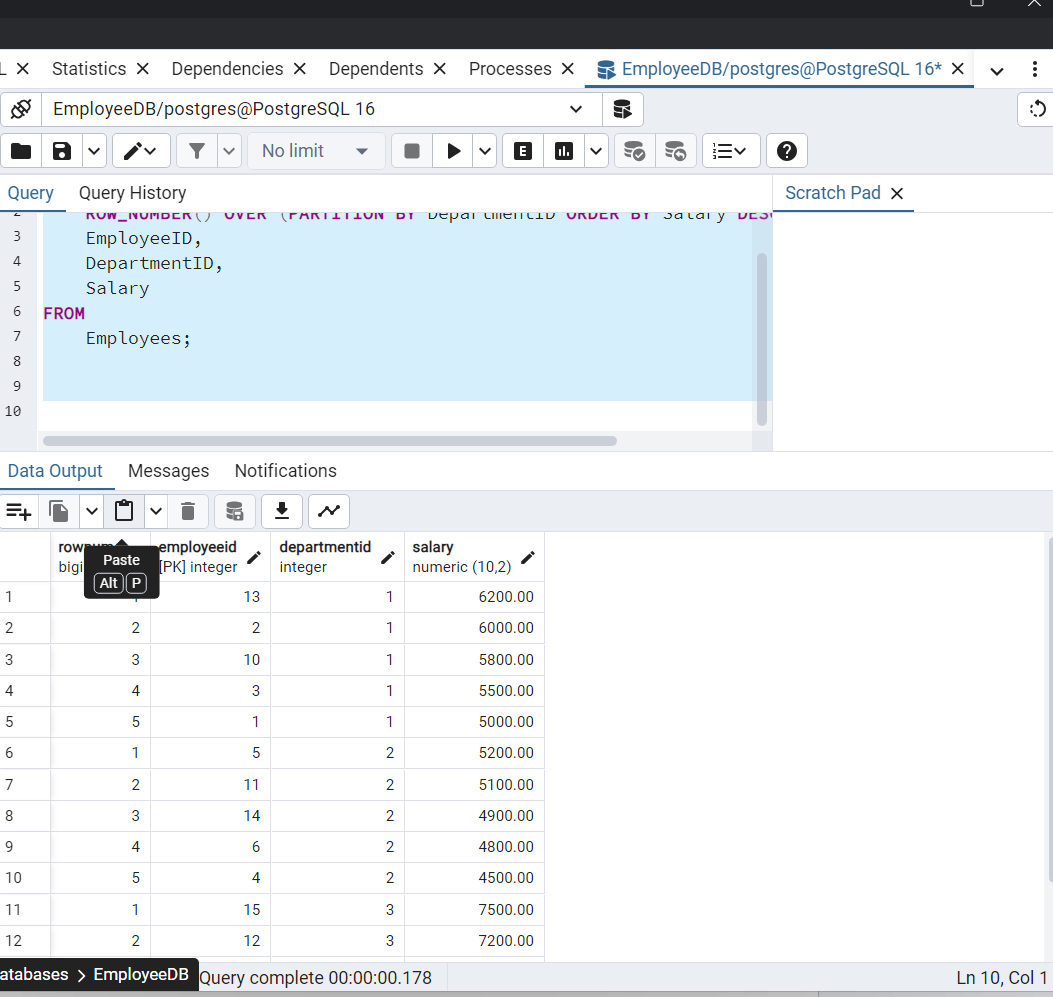
RANK()
Syntax
RANK() OVER (
[PARTITION BY partition_expression]
ORDER BY sort_expression [ASC | DESC]
)
- partition_expression: Specifies the column(s) used to divide the result set into partitions. Each partition will have its own set of ranks. This part is optional.
- sort_expression: Specifies the column(s) used to determine the ordering of the rows within each partition. The ranks are assigned based on this ordering.
- ASC | DESC: Specifies the sort order, either ascending (default) or descending.
Example:
SELECT
RANK() OVER (PARTITION BY DepartmentID ORDER BY Salary DESC) AS RankNum,
EmployeeID,
DepartmentID,
Salary
FROM
Employees;
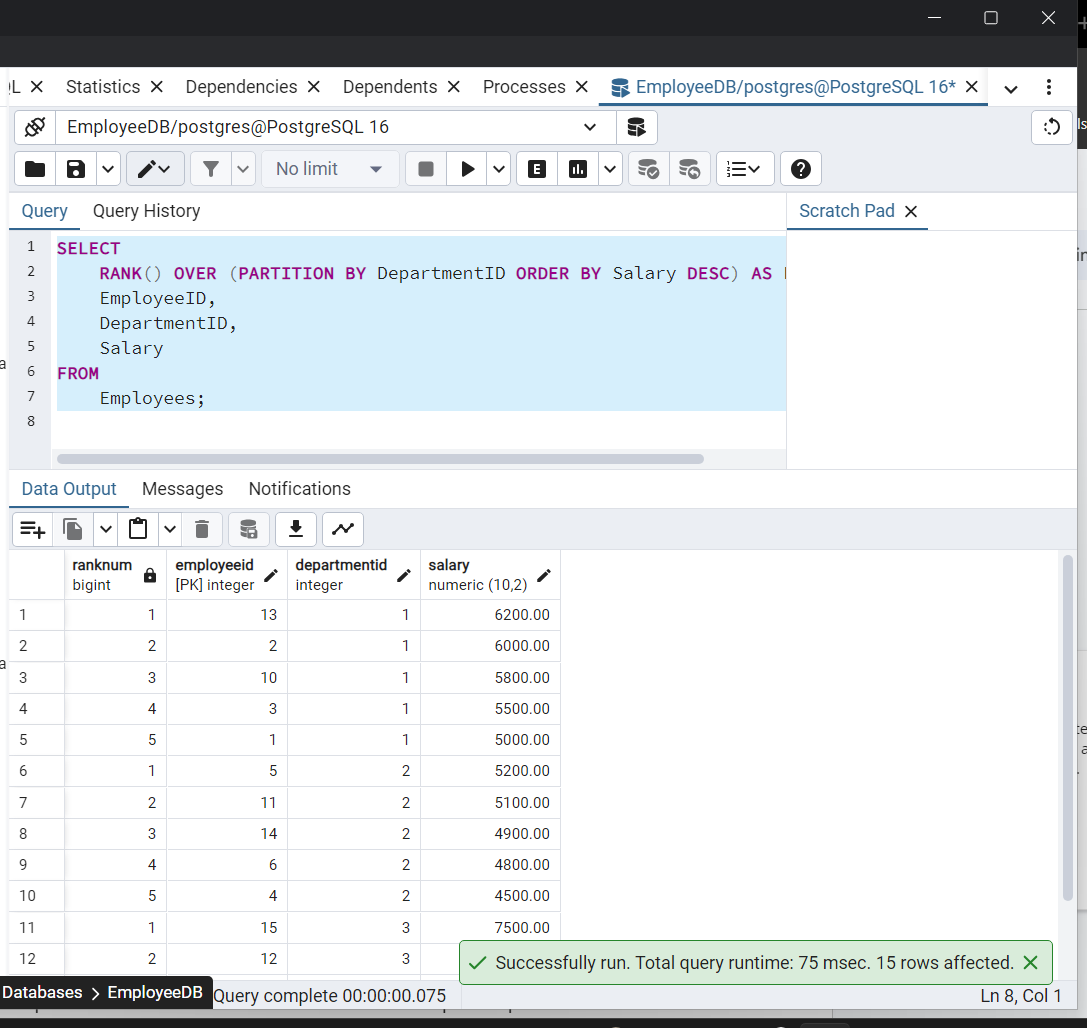
DENSE_RANK()
Syntax
DENSE_RANK() OVER (
[PARTITION BY partition_expression]
ORDER BY sort_expression [ASC | DESC]
)
- partition_expression: Specifies the column(s) used to divide the result set into partitions. Each partition will have its own set of dense ranks. This part is optional.
- sort_expression: Specifies the column(s) used to determine the ordering of the rows within each partition. The dense ranks are assigned based on this ordering.
- ASC | DESC: Specifies the sort order, either ascending (default) or descending.
Example:
SELECT
DENSE_RANK() OVER (PARTITION BY DepartmentID ORDER BY Salary DESC) AS DenseRankNum,
EmployeeID,
DepartmentID,
Salary
FROM
Employees;
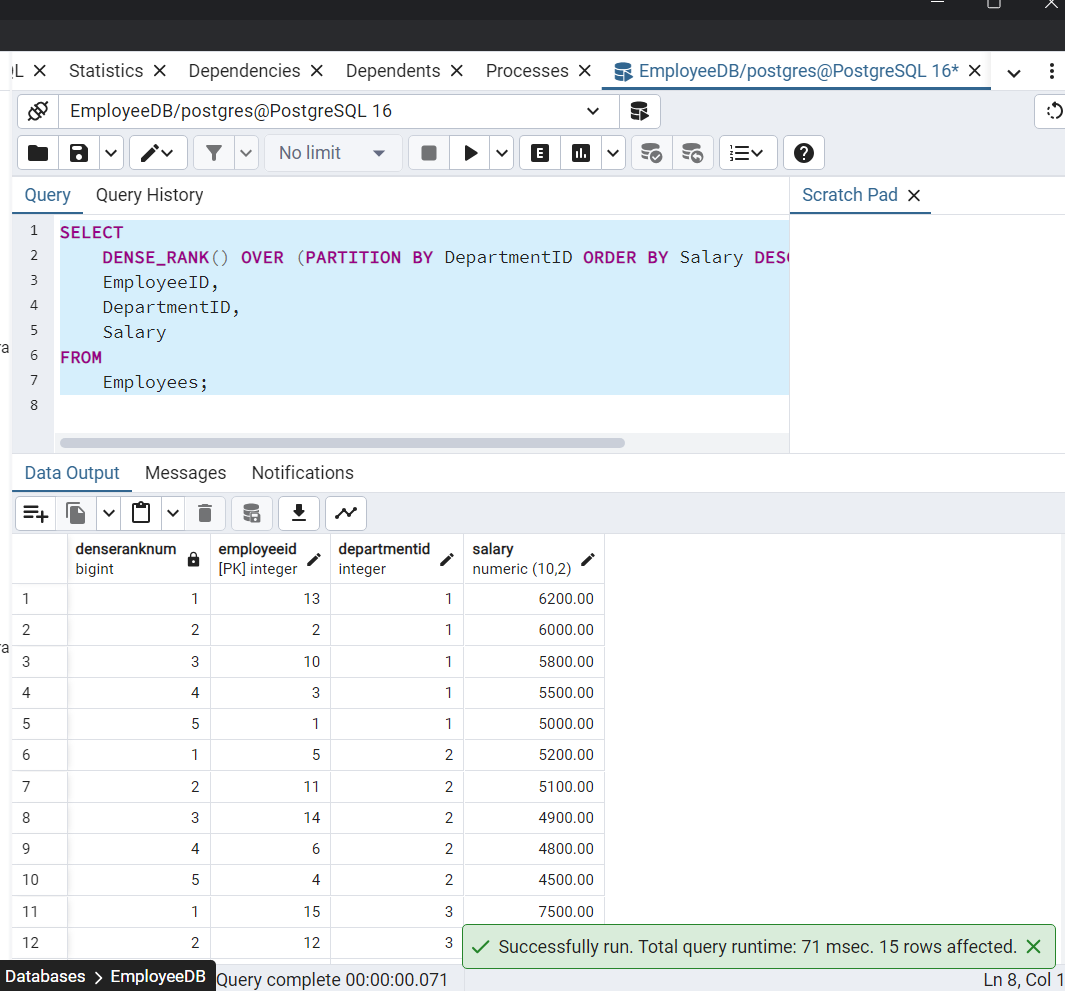
Wrapping Up!
The ROW_NUMBER() function is a powerful tool in SQL that allows you to assign unique, sequential numbers to rows within a result set. By leveraging the ROW_NUMBER() function, you can tackle a wide range of data analysis and manipulation tasks, such as pagination, ranking, duplicate elimination, and complex filtering.
Understanding the syntax and usage of ROW_NUMBER(), along with its ability to partition and order rows, empowers you to write more efficient and effective SQL queries. Whether you're working with small or large datasets, mastering the ROW_NUMBER() function is a valuable skill for any SQL practitioner. So, start exploring the capabilities of ROW_NUMBER() in your SQL queries and unlock new possibilities for data analysis and manipulation.
If you're looking for a powerful tool to streamline your data analysis and visualization workflows, check out Tooljet. Tooljet offers a user-friendly interface and a wide range of features to help you create interactive dashboards, reports, and applications with ease.
FAQs
1. How do you count row numbers in SQL?
To count row numbers in SQL, you can make use of the ROW_NUMBER() feature. It appoints a special, sequential number per row within a result set based on the specified ordering requirements. To count row numbers in SQL, you can make use of the ROW_NUMBER() feature. It appoints a special, sequential number per row within a result set based on the specified ordering requirements.
2. How to get a row ID in SQL?
In SQL, you can utilize the ROW_NUMBER() function to create a distinct row ID for each row in the result set. By specifying the proper requirements, you can designate a one-of-a-kind identifier per row. In SQL, you can utilize the ROW_NUMBER() function to create a distinct row ID for each row in the result set. By specifying the proper requirements, you can designate a one-of-a-kind identifier per row.
3. What is the difference between RANK(), ROW_NUMBER(), and DENSE_RANK() in SQL?
ROW_NUMBER(): Assigns a unique, sequential number to each row within a partition, even if there are ties in the ordering criteria. ROW_NUMBER() : Assigns a unique, sequential number to each row within a partition, even if there are ties in the ordering criteria. RANK(): Assigns the same rank to ties and skips the next rank value. For example, if two rows are tied for rank 2, the next row will be rank 4. RANK() : Assigns the same rank to ties and skips the next rank value. For example, if two rows are tied for rank 2, the next row will be rank 4. DENSE_RANK(): Assigns the same rank to ties but does not skip the next rank value. For example, if two rows are tied for rank 2, the next row will be rank 3. DENSE_RANK() : Assigns the same rank to ties but does not skip the next rank value. For example, if two rows are tied for rank 2, the next row will be rank 3.
4. How can ROW_NUMBER() OVER() be used?
ROW_NUMBER() OVER() is utilized to assign one-of-a-kind, consecutive numbers to rows within a result set. It is generally made use of in mix with the dividers BY and ORDER BY provisions to determine the dividing and purchasing of the rows. ROW_NUMBER() OVER() is utilized to assign one-of-a-kind, consecutive numbers to rows within a result set. It is generally made use of in mix with the dividers BY and ORDER BY provisions to determine the dividing and purchasing of the rows.
5. How to write ROW_NUMBER() in SQL Server?
In SQL Server, you can use the ROW_NUMBER() function as follows: In SQL Server, you can use the ROW_NUMBER() function as follows: SELECTROW_NUMBER() OVER (ORDER BY ColumnName) AS RowNum,ColumnName1,ColumnName2FROMTableName; SELECT ROW_NUMBER ( ) OVER ( ORDER BY ColumnName ) AS RowNum , ColumnName1 , ColumnName2 FROM TableName ; This will assign a unique, sequential number to each row based on the specified ordering criteria.
6. What is Rowid and Rownum in SQL?
Rowid: In some data sources like Oracle, Rowid is a special identifier for every row in a table. It is a pseudo-column that represents the physical address of a row. Rowid: In some data sources like Oracle, Rowid is a special identifier for every row in a table. It is a pseudo-column that represents the physical address of a row. Rownum: Rownum is a pseudo-column in Oracle that appoints a distinct, sequential number to every row returned by an inquiry. It resembles the ROW_NUMBER() feature yet has some constraints. Rownum: Rownum is a pseudo-column in Oracle that appoints a distinct, sequential number to every row returned by an inquiry. It resembles the ROW_NUMBER() feature yet has some constraints.
7. How to delete duplicate rows using ROW_NUMBER()?
To delete duplicate rows using ROW_NUMBER(), you can use a common table expression (CTE) and a DELETE statement. Here's an example: To delete duplicate rows using ROW_NUMBER() , you can use a common table expression (CTE) and a DELETE statement. Here's an example: WITH CTE AS (SELECTROW_NUMBER() OVER (PARTITION BY Column1, Column2 ORDER BY Column1) AS RowNum,Column1,Column2,Column3FROMTableName)DELETE FROM CTEWHERE RowNum > 1; WITH CTE AS ( SELECT ROW_NUMBER ( ) OVER ( PARTITION BY Column1 , Column2 ORDER BY Column1 ) AS RowNum , Column1 , Column2 , Column3 FROM TableName ) DELETE FROM CTE WHERE RowNum > 1 ; This query appoints row numbers within partitions defined by Column1 and Column2 and further deletes rows where RowNum is above 1, properly maintaining only the first occurrence of each distinct combination.
8. Can we use Rownum in the WHERE clause?
In Oracle, you cannot directly use Rownum in the WHERE clause to filter rows based on their position. However, you can use a subquery or a derived table to achieve the desired result. Here's an example: In Oracle, you cannot directly use Rownum in the WHERE clause to filter rows based on their position. However, you can use a subquery or a derived table to achieve the desired result. Here's an example: SELECT *FROM (SELECTRownum AS RNum,ColumnName1,ColumnName2FROMTableName)WHERE RNum BETWEEN 1 AND 10; SELECT * FROM ( SELECT Rownum AS RNum , ColumnName1 , ColumnName2 FROM TableName ) WHERE RNum BETWEEN 1 AND 10 ; This query first appoints row numbers utilizing Rownum in a subquery and then filterings system the rows based upon the appointed row numbers.
9. What is the alternative to Rownum in SQL?
The alternative to Rownum in SQL is the ROW_NUMBER() feature. ROW_NUMBER() is a common SQL feature that provides similar capability to Rownum yet with even more adaptability and compatibility across different data source systems.
10. Does SQL Server have Rownum?
SQL Server does not have a straight equivalent to Oracle's Rownum pseudo-column. Nevertheless, you can attain comparable functionality utilizing the ROW_NUMBER() feature in SQL Server. SQL Server does not have a straight equivalent to Oracle's Rownum pseudo-column. Nevertheless, you can attain comparable functionality utilizing the ROW_NUMBER() feature in SQL Server. SELECTROW_NUMBER() OVER (ORDER BY ColumnName) AS RowNum,ColumnName1,ColumnName2FROMTableName; SELECT ROW_NUMBER ( ) OVER ( ORDER BY ColumnName ) AS RowNum , ColumnName1 , ColumnName2 FROM TableName ; This query assigns unique, sequential row numbers to each row based on the specified ordering criteria, similar to Rownum in Oracle.

Author|310 articles published


upGrad Learner Support
Talk to our experts. We are available 7 days a week, 10 AM to 7 PM
Indian Nationals
Foreign Nationals
Disclaimer
The above statistics depend on various factors and individual results may vary. Past performance is no guarantee of future results.
The student assumes full responsibility for all expenses associated with visas, travel, & related costs. upGrad does not .























-ae8d039bbd2a41318308f8d26b52ac8f.svg)
-35c169da468a4cc481c6a8505a74826d.webp&w=128&q=75)
-7f4b4f34e09d42bfa73b58f4a230cffa.webp&w=128&q=75)



